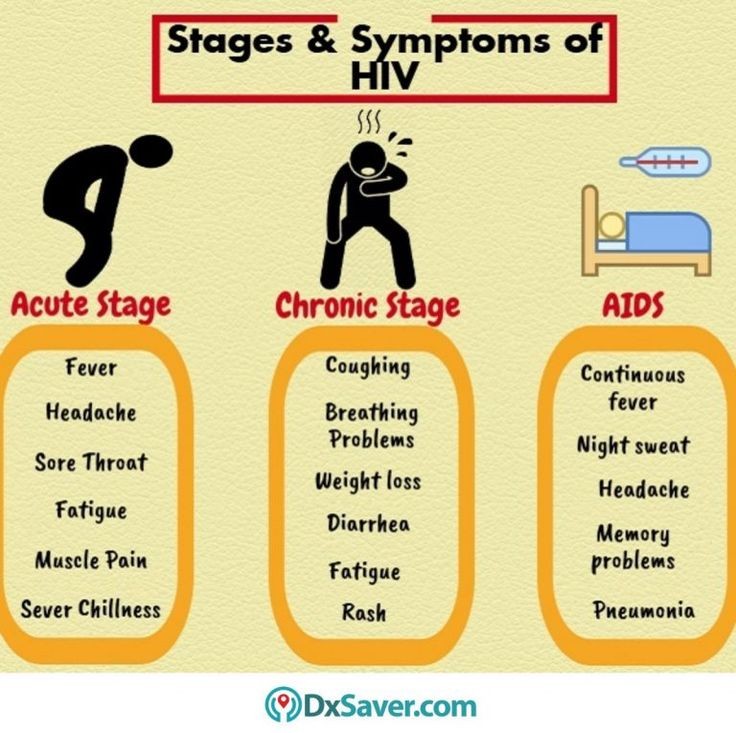
Contents
HIV Tests, Symptoms, Signs, and Stages of Infection
Untreated HIV infection progresses over time and impairs the immune system by destroying CD4 lymphocyte cells. This progression occurs in stages and requires laboratory confirmation of HIV infection.
There are multiple staging systems. For example, the CDC uses a staging system based on immune system damage:
- Stage 1 disease is the earliest phase. This stage has no unusual infections or cancers associated with AIDS. Although blood tests are positive for HIV, the CD4 cell count is at least 500 cells per microliter of blood (or >29% of all lymphocytes).
- Stage 2 disease occurs when the CD4 count is between 200-499 cells per microliter (14%-28% of all lymphocytes), but there are no AIDS-defining conditions present.
- Stage 3 disease is synonymous with AIDS and is the most severe stage. It can be diagnosed by CD4 counts below 200 cells per microliter.
HIV can also be conceptualized according to acute infection, clinical latency, and AIDS.
- Acute infection: Two to four weeks after infection, patients may experience an acute illness called acute retroviral syndrome (ARS) or primary HIV infection. During this period, large amounts of virus are produced. The virus uses CD4 cells to replicate and destroys them. Eventually, the immune response suppresses the virus but does not eliminate it from the body.
- Clinical latency: After acute infection, HIV moves into a stage called clinical latency. In this stage, HIV reproduces at low levels, and infected individuals may have an undetectable viral load and healthy CD4 cell count. There are usually few if any symptoms. This phase can last up to eight years or longer, but some people progress through this phase faster than others. It is important to remember that people can transmit HIV during this phase.
- AIDS: AIDS occurs when the CD4 count falls below 200 cells per cubic millimeter of blood. People with AIDS have severely impaired immune systems and are vulnerable to opportunistic infections. Without treatment, survival is typically about three years once diagnosed with AIDS, and life expectancy falls to about one year once a dangerous opportunistic infection occurs.
What conditions show a person has full-blown AIDS?
AIDS-defining conditions include:
- Candidiasis of bronchi, trachea, lungs, or esophagus
- Cervical cancer, invasive
- Disseminated or extrapulmonary coccidioidomycosis or Cryptococcus
- Chronic intestinal cryptosporidiosis or isosporiasis
- Cytomegalovirus disease of the retina or an unusual site (other than liver, spleen, or nodes)
- HIV encephalopathy
- Herpes simplex that does not heal or that occurs in the lungs or esophagus
- Histoplasmosis that is disseminated or extrapulmonary
- Kaposi’s sarcoma
- Lymphoid interstitial pneumonia and/or pulmonary lymphoid hyperplasia*
- Selected lymphomas including Burkitt’s, immunoblastic, or arising in the brain
- Disseminated or extrapulmonary Mycobacterium avium-intracellulare complex or Mycobacterium kansasii, or other species of mycobacterium
- Mycobacterium tuberculosis infection
- Pneumocystis jirovecii pneumonia
- Recurrent bacterial pneumonia
- Progressive multifocal leukoencephalopathy
- Recurrent or multiple bacterial infections
- Recurrent Salmonella septicemia
- Toxoplasmosis of brain
- Wasting syndrome associated with HIV infection
QUESTION
What are HIV symptoms and signs?
Between one-third and one-half of HIV-infected individuals will experience symptoms such as fatigue, achiness, sore throat, enlarged lymph nodes, and loss of appetite. Other symptoms may include fever, neck stiffness, headache, rash, thrush, mouth sores, recurrent vaginal yeast infections, and nonspecific symptoms like fatigue. If untreated, HIV progresses to stage 3 after about 10 years, with increased susceptibility to infections and cancers. Some infections or cancers may directly cause symptoms such as shortness of breath and cough.
What tests diagnose HIV and AIDS?
HIV infection can be diagnosed by detecting the virus directly or by detecting antibodies made against the virus. Antibody testing is often performed in two parts: a sensitive screening test followed by a second confirmatory test. Newer fourth-generation tests combine viral detection and antibody detection, allowing for faster results. Viral load testing can be used to monitor treatment effectiveness and diagnose acute retroviral illness.
The CDC recommends HIV testing for all individuals between the ages of 13 and 64, with frequent testing for high-risk individuals. Pregnant women should be tested, and victims of sexual assault should also be tested. People diagnosed with other sexually transmitted diseases should be tested for HIV as well.
Medically reviewed by Robert Cox, MD; American Board of Internal Medicine with subspecialty in Infectious Disease
United States. Department of Health and Human Services. "Guidelines for the use of antiretroviral agents in HIV-1-infected adults and adolescents." Jan. 10, 2011. .
United States. Department of Health and Human Services. "Guidelines for the use of antiretroviral agents in HIV-1-infected adults and adolescents." Jan. 10, 2011. .


